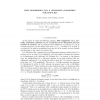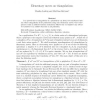98
Voted
DCG
2006
15 years 23 days ago
2006
We propose an algorithm to compute a conforming Delaunay mesh of a bounded domain specified by a piecewise linear complex. Arbitrarily small input angles are allowed, and the inpu...
75
Voted
DCG
2006
15 years 23 days ago
2006
118
click to vote
DCG
2006
15 years 23 days ago
2006
Abstract. Hyperbolic area is characterized as the unique continuous isometry invariant simple valuation on convex polygons in H2 . We then show that continuous isometry invariant s...
91
Voted
DCG
2006
15 years 23 days ago
2006
The maximal area of a polygon with n = 2m edges and unit diameter is not known when m 5, nor is the maximal perimeter of a convex polygon with n = 2m edges and unit diameter known...
108
Voted
DCG
2006
15 years 23 days ago
2006
Abstract. We show that there exist k-neighborly centrally symmetric ddimensional polytopes with 2(n + d) vertices, where k(d, n) = ,, d 1 + log((d + n)/d)
87
Voted
DCG
2006
15 years 23 days ago
2006
This paper sheds a new light on the split decomposition theory and T-theory from the viewpoint of convex analysis and polyhedral geometry. By regarding finite metrics as discrete ...
76
Voted
DCG
2006
15 years 23 days ago
2006
74
Voted
DCG
2006
15 years 23 days ago
2006
109
Voted
DCG
2006
15 years 23 days ago
2006
We show, with an elementary proof, that the number of halving simplices in a set of n points in R4 in general position is O(n4-2/45). This improves the previous bound of O(n4-1/13...
85
Voted
DCG
2006
15 years 23 days ago
2006
It is proved that a triangulation of a polyhedron can always be transformed into any other triangulation of the polyhedron using only elementary moves. One consequence is that an ...


